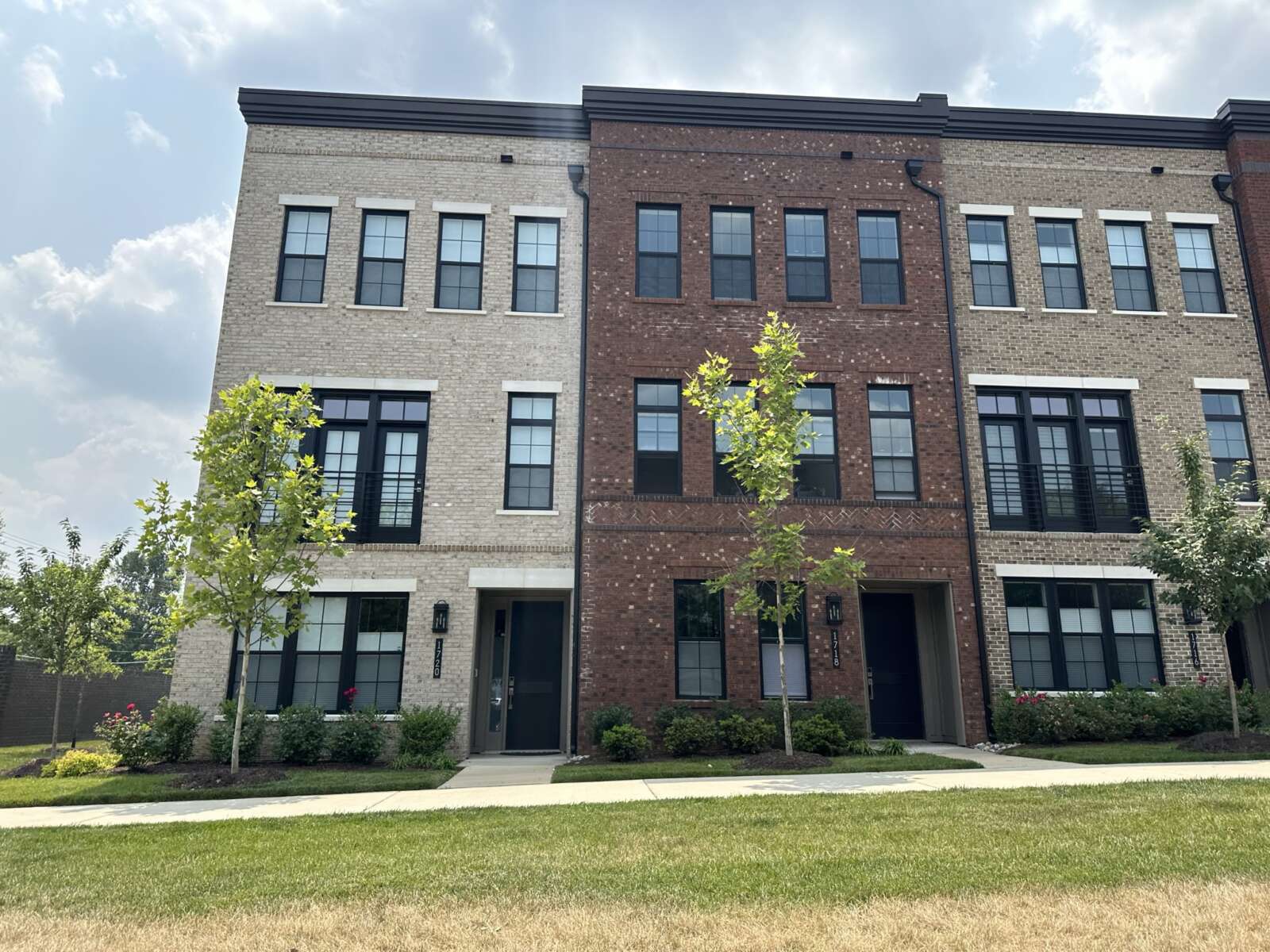
Tysons is going to need more housing.
Home to 17,000 people in 2010, the urban center saw its population grow to 29,620 people by 2021, according to a market study released Friday (Aug. 4) by the Tysons Community Alliance. Fairfax County staff reported earlier this year that there are now 30,124 residents.
Much of that influx came just in the past five years. Tysons added 13,000 households at a growth rate of 19% from 2018 to 2021 — tripling the 6% seen from 2015 to 2018, the market study found.
Its residential growth has easily exceeded that of Fairfax County as a whole (4% from 2018-2021) as well as the overall D.C. region (7% over that time period).
“Tysons is no longer just a place to shop and go to work,” said Providence District Supervisor Dalia Palchik, who represents most of Tysons. “The addition of Metro and now the completion of the Silver Line, investment in parks and public amenities, as well as the construction of bike trails, is creating connections within Tysons, to the region and beyond. People recognize Tysons as the type of community that they want to call home.”
While the county’s population has started to stagnate, Tysons is projected to reach more than 42,000 residents by 2030, though that pace would still fall short of the county’s goal of 100,000 residents by 2050.
To accommodate that growth, the area will need to add 4,400 more housing units, including an additional 1,900 affordable units, by 2032, the report estimates.
Tysons has made progress on building up its housing stock, which totals 8,600 units with 1,200 coming online since 2020 — a 16% increase. Another 1,600 units are under construction, and 624 have been approved but are still in planning, including about 516 units in the all-affordable Dominion Square West project.
Of the roughly 2,500 existing affordable units, 1,800 are “naturally occurring” because their market rate is affordable to households earning up to 80% of the area median income (AMI), which is $152,000 for a household of four people in the D.C. area.
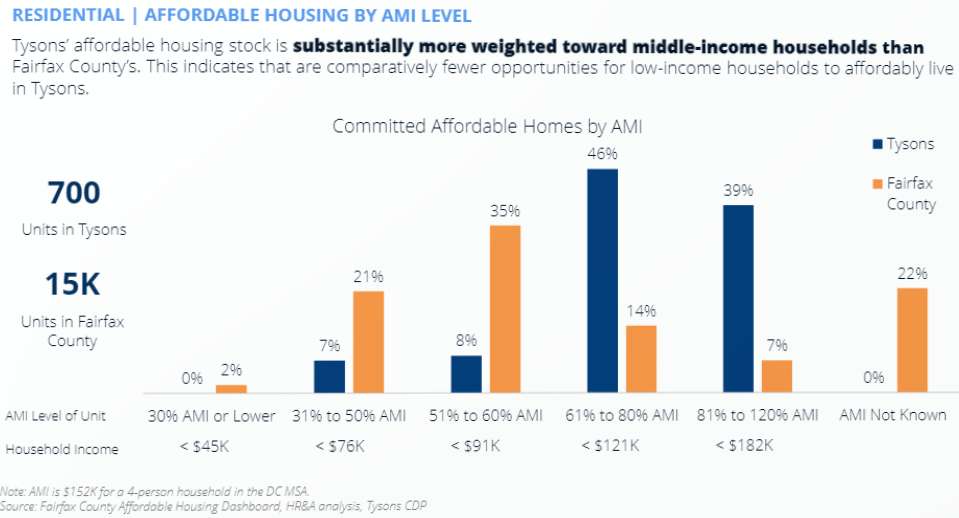
However, the vast majority of the 700 committed affordable housing units in Tysons is aimed at people making 60% or more of the AMI. Only 7% are available to people earning under $76,000 a year, and there are no units affordable to people making under $45,000. Read More
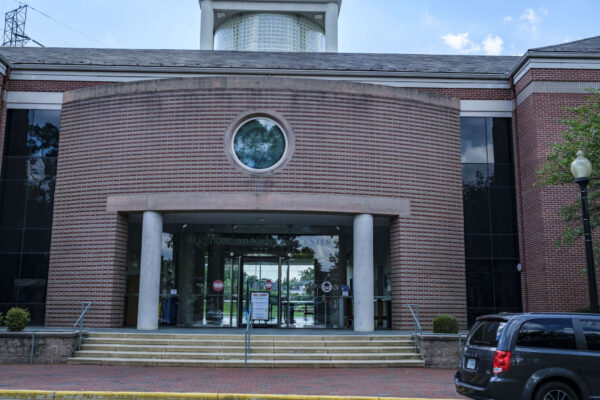
After sleepy population growth over the last decade, Herndon planners expect the town will see significant population growth in the coming 10 to 15 years.
In a June memo to the Town of Herndon’s planning commission, head of long-range planning Ahmad Zaki said the changes must inform the town’s planning decisions.
Although the town’s decennial census showed a growth of 1,263 people between 2010 and 2020, that trend is expected to “change significantly in the coming 10-15 years,” Zaki wrote.
“By 2030 about 9,000 people will be added to the town’s population,” the memo states.
Housing stock in the Town of Herndon has increased by 206 units overall, according to the memo.
However, the town’s population estimates diverge from the ones calculated by Fairfax County, which said in its 2022 demographic report that the town shrank by 926 individuals and added 247 housing units between 2010 and 2020.
“The discrepancies could be due to household size and vacancy rate factors used in these estimates,” Zaki suggested in his memo.
The American Community Survey — an annual survey conducted by the Census Bureau — estimates suggest that the town’s population will grow from 25,935 individuals in 2025 to 39,430 individuals in 2040.
“The 2025 and onward population and housing projections are estimated using the new development projects with residential components that are within the review pipeline, and future land use growth data gleaned from the Town’s 2030 Comprehensive Plan and the various small area plans recently approved,” the memo states.
Town planners note that there are an “unprecedented” number of new housing developments expected in the town over the next 25 years, particularly between 2025 and 2030. That means there would be roughly two new housing units per day, according to the town.
“This magnitude of development, if realized and not prepared for, can put significant pressure on the town’s road network, utility infrastructure, and community services in a relatively short time,” the memo states.
The racial composition of the town has remained relatively consistent over the last 10 years, according to to the town. The 2020 census indicated that the median age for individuals in Herndon is age 35 — roughly three years younger than the median age in Virginia.
Between 2010 and 2015, the number of Spanish-speaking individuals increased by 10%, while the number of people speaking only English has declined by 9% over the same time period.
The town is expected to discuss population trends at a meeting before the commission tonight (Monday).
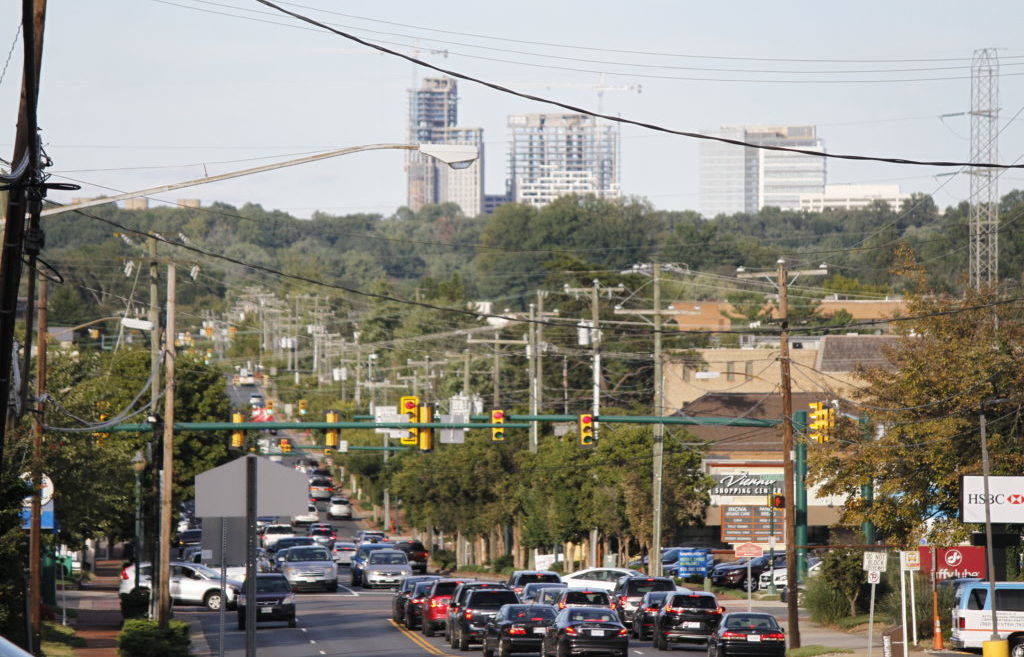
Fairfax County’s population growth has slowed to a crawl, and it’s unclear if that’s a temporary result of the pandemic or a more permanent trend.
The newly published 2022 Demographic Report indicates that the county’s population has slowed since 2020. It decreased in 2021 for the first time since 1840, though 2022 saw a slight rebound from that — an increase of a fraction of a percent.
According to a press release on the report from the county:
Population growth has slowed down in the county since 2020. In fact, in 2021 the total population decreased, resulting in the first negative growth recorded in Fairfax County since 1840.
The Census Bureau Vintage 2021 Population estimates indicate that all factors — largely reduced international in-migration, declined natural growth and increased domestic out-migration — contributed to the slowing of population growth. The 2022 Demographic Report shows that our population growth saw a mild recovery (the total population in 2022 was estimated to be 1,172,646, a 0.2% annual growth), it remains to be seen whether the slowed growth is temporary due to the pandemic.
Still, population forecasts estimate continued but slow growth over the next few decades, from the current 1.2 million up to 1.4 million by 2050.
While the Town of Herndon’s population is expected to swell from 22,308 people to 28,385 by 2050, the forecasts estimate populations in Clifton and Vienna will remain fairly stagnant. Vienna is estimated to hit 17,326 residents by 2030 and stay around that number through 2050.
The report indicated the market value of housing units continues to outpace increases in household income, particularly in the Sully District:
In 2022, the county’s median market value of owned housing units was $648,270, a 10.9% increase from 2021. Among Supervisor Districts, the highest increase was in the Sully District (up 14%), and the lowest was in the Hunter Mill District (up 7.8%). The average monthly rent increased from $1,787 in 2020 to $1,913 in 2021, based on the latest 2021 Rental Housing Complex Analysis report.
Meanwhile, the report noted that the 2021 American Community Survey 1-Year estimated Fairfax County’s median household income only increased 4.5% between 2019 and 2021 — growing only half as fast as housing costs.
The survey estimated the county’s median household income as $134,115, which is almost double the national average of $69,717.
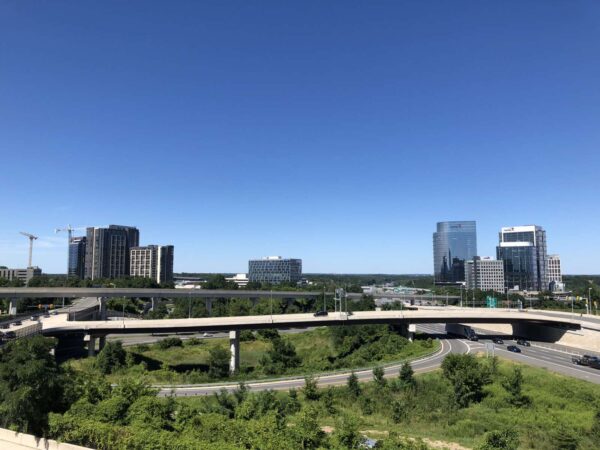
Tysons is making good progress on fulfilling Fairfax County’s goal of turning it into a place where people live as well as work, county staff say.
Since the Tysons Comprehensive Plan was adopted in 2010, the urban center has seen its population jump from 17,000 to 30,124 residents, according to data shared last week with the Fairfax County Planning Commission’s Tysons Committee.
Over that time period, the housing stock has increased from 8,943 units to 14,253, with another 1,613 units under construction, as of July 2022.
That influx of residents narrowed the ratio of jobs-to-households from over 11-to-1 in 2010 to about 6-to-1 in 2022. Aiming for 100,000 residents and 200,000 jobs by 2050, the plan posited a ratio of 4-to-1 as an ideal mix for Tysons.
“Tysons growth continues to be in line with plan growth projections, and we think residential is tracking probably at a faster pace than we anticipated, but there is still capacity in the pipeline,” Fairfax County Department of Planning and Development Urban Centers Section Chief Suzie Battista said at the Jan. 12 committee meeting.
Based on data compiled for the Tysons Tracker, an interactive platform that launched in 2021 and is currently being updated annually, county staff project that development will fall about 9 million square feet short of the 69.9-million-square-feet goal set forth in the plan for 2024.
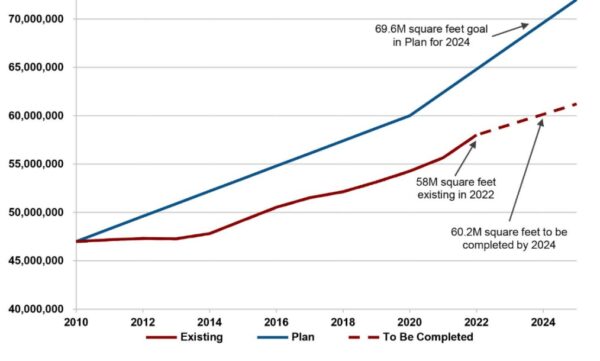
Battista noted that the full impact of the COVID-19 pandemic and completion of Metro’s Silver Line extension are still unknown, but she doesn’t “think there’s any cause for concern.”
From August 2021 through July 2022, developers finished five buildings with 1.3 million square feet of space, including Capital One Hall and the Hanover apartments. Another 3.2 million square feet is under construction, and projects totaling 1 million square feet got site plan approval.
About two-thirds of the upcoming development is residential, which has grown by over 6.6 million square feet since 2011 — exceeding the roughly 3 million square feet of added office space.
Notably, the increase in housing has included 773 affordable or workforce dwelling units to date, not including the planned, all-affordable Dominion Square West and Somos projects. Tysons had just 40 units of affordable housing prior to 2010, according to the tracker.
Battista says developers seem open to the county’s revamped ADU/WDU policy for Tysons, which reduced the percentage of affordable units required in each project but lowered the targeted area median income (AMI) levels.
“We were finding from the development community, some of the higher tiers, that wasn’t really getting at the goal of what we were trying to accomplish with affordable housing just based on the AMIs in this area,” she said. Read More

After more than 50 meetings, Fairfax County will present draft amendments to Reston’s comprehensive plan at public meetings this fall, advancing the first major update to the planning document since 2015.
The process kicked off in 2020 to determine how new development will impact the community, public infrastructure and growth-related issues. Reston has seen more than 50 rezoning applications since the last update in 2015, prompting concerns about growth management.
At a media briefing today (Wednesday), Hunter Mill District Alcorn noted that the update covers all of Reston, unlike previous plans that addressed only parts of it.
“This is one Reston. This is all of Reston,” Alcorn said.
The new plan will go to the Fairfax County Planning Commission on Nov. 2, followed by a vote by the Fairfax County Board of Supervisors on Dec. 6.
A 31-member community task force approved draft recommendations on Aug. 28 after 58 public meetings. Hunter Mill District Supervisor Walter Alcorn convened the task force after he took office in 2020.
Some controversial topics — like granting a developer more density for providing more community benefits — remain unresolved. A county-led subgroup is studying the issue, according to Alcorn. It’s unclear if the provision will make to to the final report.
Rather than broadly limiting, restricting or expanding development, the plan makes site-specific changes to a limited number of areas.
In Town Center North, where land is jointly owned by the county and Inova, the plan suggests limiting residential development to Inova-owned property and a maximum of 1,000 residential dwelling units. In the same area, nonresidential development would be limited to 150,000 square feet. County-owned land would be reserved for civic uses with some retail.
Near a proposed extension of South Lakes Drive and north of the Dulles Toll Road, the draft calls for redevelopment. In the Roland Clarke Place neighborhood, a provision for public uses was added in an area currently planned for about 75% residential and 25% non-residential development.
Affordable housing — one of Alcorn’s priorities — remains unchanged outside of Reston’s transit station areas. But within the TSAs, the proposed language recommends setting aside at least 12% of residential units as affordable housing.
For proposals with high density — 1.0 floor-area ratio or above — an increased proportion of affordable housing is expected, although no specific numbers are cited. Overall, rental rates for Workforce Dwelling Units within the TSAs target mostly 71 to 90% of the area media income.
“It’s still one element that’s out there,” Alcorn said.
Additionally, the draft report leaves language on preserving Reston’s two golf courses untouched, though a study group recently argued that change is needed at the Reston National Golf Course.
Alcorn acknowledged that more open space is needed in Reston. The plan calls for indoor and outdoor cultural activities, community gathering spaces, and enhanced public art.
It also embraces a multimodal transportation system, along with placemaking guidance in transit-oriented areas.
The plan covers 14 areas based on the seven guiding principles championed by Reston founder Robert E. Simon. New topics include a community health chapter with categories like food systems, active living, social cohesion and health care services.
An equity chapter builds on the county’s One Fairfax policy to remove barriers that “perpetuate injustice in our society” and build a more “inclusive economy,” according to St. Clair Williams, a senior planner with the county’s Department of Planning and Development.
Similarly, the planning principle of economic development is consistent with the county’s policies, but the recommendations are simply “aspirational,” Williams noted.
He noted that public meetings will continue through September with stakeholders before the planning commission’s official review.
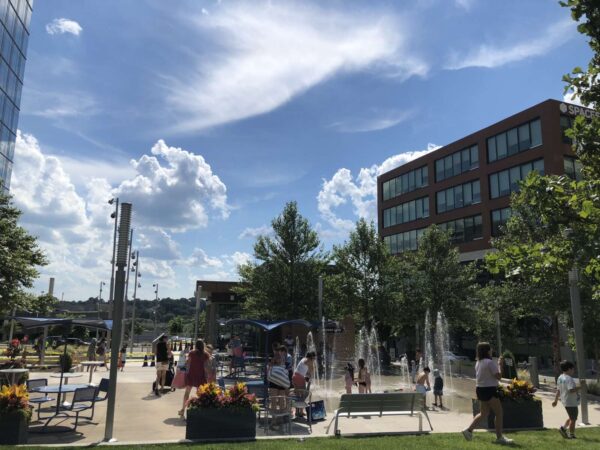
What Was Behind Tuesday’s Storms — “Hundreds of trees were toppled and hundreds of thousands of people lost power Tuesday afternoon and evening as three storm complexes roared across the Washington region. The storms were fueled by hot and humid air that surged into the region, and were powered and sustained by strong high-altitude winds along an approaching cold front.” [Capital Weather Gang]
Firefighter Charged in Fairfax County Armed Robbery — “A D.C. firefighter has been arrested and charged with robbery after police say he brandished a gun and took someone’s property in Fairfax County, Virginia. Fairfax County Police said the robbery happened in May” [WTOP]
Police Investigate Dunkin’ Donuts Burglaries — Fairfax County and Alexandria City police are investigating at least three burglaries of Dunkin’ Donuts in Springfield, Belle Haven and Potomac Yard. The incidents all occurred during the morning of July 7, but police haven’t confirmed whether they were committed by the same people. [ALXnow]
Fairfax County Top in State for Population Growth — “In the last 50 years, Fairfax County saw the largest population increase in Virginia. During that same time, Norfolk saw the largest population decline…Mark Mather at the Population Reference Bureau says the next 50 years are not going to have the same trends.” [WVTF]
Same-Day Voter Registration Coming — “Same-day voter registration is taking effect in the state in time for the congressional midterms in November, a significant shift from the way Virginia elections have worked in the past…The new law will allow voters to fill out a registration form and cast a ballot after that deadline, up to and including Election Day.” [Virginia Mercury]
Food Drive Planned in West Springfield — “@MoveInterstate will be hosting a #FillATruck food drive at their #Springfield HQ located at 5801 Rolling Road, from 07/18-07/29. All donations will be donated to Ecumenical Community Helping Others (ECHO) and will help families in the #FairfaxCounty community.” [Supervisor Penny Gross/Twitter]
Langley HS Alum Coaches GMU Volleyball — “Years later, when receiving a second opportunity to join the George Mason University women’s volleyball team, Megan Shiffett Bachmann jumped at the chance and accepted. The 2008 Langley High School graduate recently was named the new head women’s coach of the Division I Mason program.” [Sun Gazette/Inside NoVA]
Park Authority Names Top Volunteers — “The Fairfax County Park Authority will honor 21 individual volunteers named 2022 Outstanding Volunteers and selected by their peers from across the park system…Approximately 4,000 volunteers give of their time and talent annually and take on a multitude of tasks.” [FCPA]
Tysons IT Consultant to Help Startups — “Booz Allen Hamilton has launched a venture capital unit that aims to help young companies speed the development of technologies used by the federal government…Booz Allen Ventures LLC will invest $100 million over five years in firms developing artificial intelligence, machine learning, cybersecurity and defense technologies, the company said.” [Washington Business Journal]
It’s Thursday — Partly cloudy throughout the day. High of 86 and low of 72. Sunrise at 5:56 am and sunset at 8:35 pm. [Weather.gov]
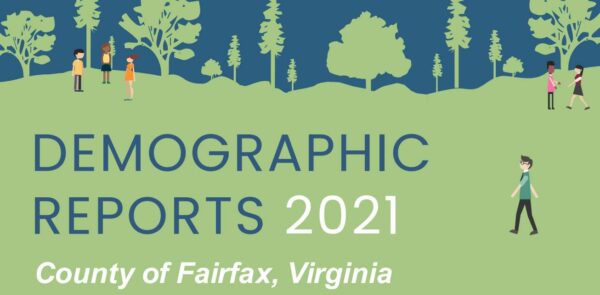
A newly released report shows Fairfax County’s population decreased, reversing a trend of growth.
According to the report from the Department of Management and Budget, the county’s population decreased during 2020-2021 from 1,171,800 to 1,170,000 people — a decline of 1,800 people, or 0.2%.
That estimate is similar to another from the U.S. Census Bureau, which also suggests the county saw a smaller percentage drop in population than what many of its neighbors had.
Population changes in the D.C. region
| County/Area | 2020 Census (April 1) | 2021 estimate (July 1) | % change |
|---|---|---|---|
| Arlington | 238,643 | 232,965 | -2.4% |
| D.C. | 689,545 | 670,050 | -2.8% |
| Fairfax | 1,150,309 | 1,139,720 | -.09% |
| Loudoun | 420,959 | 427,592 | 1.6% |
| Montgomery | 1,062,061 | 1,054,827 | -0.7% |
| Prince George’s | 967,201 | 955,306 | -1.2% |
| Prince William | 482,204 | 484,472 | 0.5% |
In fact, the Census reported last week that more than 73% of U.S. counties experienced a “natural decrease” in population from 2020 to 2021, a trend that it attributes to fewer births, an aging populace, and higher mortality rates — including from COVID-19.
In Fairfax County, a tight housing supply and increases in remote work that allow people more flexibility in where they live could also be contributing factors.
“Housing construction delays created less new space for population growth and single-family dwelling unit vacancy was up in 2021,” the budget department’s Economic, Demographic and Statistical Research unit, which compiled the report, told FFXnow.
The housing stock in Fairfax County has increased over the years, but the rate significantly slowed last year. The county only added 1,500 housing units in 2021, half of what was added in 2020.
Don’t expect the slowdown in growth to last, however. According to the demographic report’s forecasts, the county will hit 1.2 million people by 2025, exceed 1.3 million by 2040, and reach 1.38 million people in 2050.
As reported by the 2020 Census, Fairfax County is now a minority-majority county, with white individuals making up 49.5% of the population. The remainder of residents breaks down as 20.5% Asian or Pacific Islander, 19.8% other, 9.6% Black, and 0.6% Native American. 17.3% of the county is Hispanic.
The demographic report includes household and family income data, but those numbers haven’t been updated for 2020 or 2021 “due to COVID-19 introduced nonresponse bias.”
The county uses the demographics reports to develop policy, write grants, budget, plan infrastructure projects, and more.

